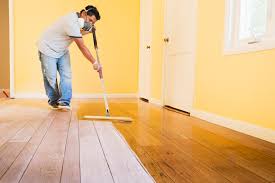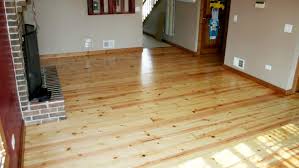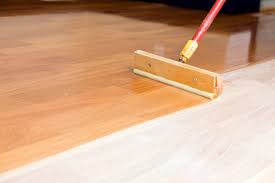How Often Should Hardwood Floors Be Refinished?
With proper care, a well-built hardwood floor can last a lifetime, even generations. But over time, the wood inevitably starts showing signs of wear and age. Scratches accumulate, uneven coloring may occur (especially in areas where the floors are exposed to sunlight), and floors begin to appear dull. You can refresh your floors by refinishing them—effectively by having them sanded, re-stained and sealed. But at what point should you consider having your hardwood floors refinished?
There is no set answer to this question. It depends on a number of factors, including the type of wood, foot traffic patterns, natural wear and your own personal aesthetic. Even with the best of care, most floors start showing their age after about 10 years. But for most households, simple wear-and-tear may cause the floors to need refinishing sooner than that. Here are a few signs and tips to help you decide when your hardwood floors need refinishing.
Excessive Scratches
These days, the “weathered” or “distressed” look is popular with wood floors, but that look is best achieved purposely by wire brushing evenly across the floor. For most of us, scratches don’t make the floor look “worn”—just scratched. Also, scratches can affect the integrity of whatever sealant may have been used, making the floors more vulnerable to the elements. A bit of scratching is natural, but deep or excessive scratches might need to be sanded out and refinished.
Discoloration
If your wood floors start to appear sun-bleached, it may not be a serious problem, but it can give your floors an uneven, unattractive look, and you may choose to refinish them just to recover an even coloring. If floorboards start getting a dull, gray hue, it’s a potential sign of damage from moisture over time, and you’ll want to refinish them to protect the wood from further damage. Let it go too long, and the floors will need to be replaced.
Areas of Dullness
A wood floor’s finish is as much a part of the aesthetic as its color, whether that finish is glossy, satin, matte or brushed. Over time, especially in high-traffic areas, you may start to notice the finish taking on a dull appearance compared to other parts of the floor. This inconsistency can make your floors look worn, uneven and even neglected. In most cases, refinishing will restore the floor to its consistent beautiful sheen.
A Note of Caution
Although refinishing your floors can make them look fresh and new, every time you do it, you’re removing a layer of wood. Solid hardwood floors can endure this process several times. Engineered wood floors can only handle it once or twice at most. But floors that get refinished too often can eventually get to the point where they lose beauty and just don’t look as nice anymore. For that reason, we recommend refinishing your floors only when it’s apparent that they need it, and not just for the sake of change.

Hardwood Floor Care and Maintenance
The most important step for basic hardwood floor care is to regularly vacuum, sweep or dust mop the floors to remove dirt and objects that can cause scratching. If there’s a risk that your vacuum might scar the floor’s surface, use the brush attachment connected to your appliance. Always wipe up any spills or mud right away, even if your floor is protected with a polyurethane finish.
Humidity levels can affect hardwood flooring, especially if they vary drastically. It’s best to keep the relative humidity between 35% and 55%, if possible, using a humidifier or dehumidifier as needed. If you notice shrinkage, cracks, cupping, or buckling, you may need to regulate the humidity in your home.
To properly clean your hardwood floor, it’s important to know what kind of finish is present: is it a polyurethane/other surface finish or a wax/penetrating stain finish? Polyurethane floors should never be waxed, and wax finished floors need to be periodically buffed to keep the shine. When buffing no longer brings back the shine, it’s time to wax. Polyurethane floors can be lightly damp mopped, provided the water is not allowed to stand. A waxed floor should never be mopped regardless of how wet the mop is.
When mopping hardwood floors with a polyurethane finish, use warm water and a small amount of dish washing liquid or wood cleaner. Make sure you are using a damp mop and not a wet one; be sure to wring out the mop well before applying it to the floor. Try to mop with the grain as much as possible, and wipe up any excess water with a soft cloth, polishing the hardwood floors as you go. Avoid using products with ammonia, vinegar, or abrasive cleaners. When in doubt, ask the manufacturer or installer of your floors what products and methods to use for cleaning.

Regular Cleaning
Through your daily traffic in the house, you may notice that your flooring surfaces may begin to dull slightly. This is most likely as a result of residual dirt tracked into the house by your family or your pets. A good procedure to clean your floors in an efficient and proper manner is to initially sweep the area with a soft bristle broom. It is important to examine the broom’s bristles before starting, as some brooms are not appropriate for some surface areas and can also scratch or mar the finish. It is best to try the broom on a small area of the floor first to insure that it’s not damaging the floor in any way.
Next, mix a solution of mild soap and water, preferably on the lighter side of the soap to insure a non-slip surface is maintained. Using a soft sponge mop, evenly mop the entire surface area until clean, and then let the area air dry. If this procedure is maintained on a regular basis, you will certainly prolong the beauty of your floors for a very long time. Beyond this, there are other steps that can be taken less frequently that can add life and beauty to your floors, such as floor treatments.
Monthly Floor Treatment
Floor treatments are widely available cleaning products specifically designed to add luster and shine, all while conditioning your hardwood floors. While these products are excessive to use on a weekly basis, it is certainly reasonable to treat your floor to this process every month or so, depending on traffic, and the simple steps needed to do so are well worth the effort. Be sure to verify the contents and application procedures for your specific product, and should any questions arise, refer to your local home products retailer for further advice. Sometimes mixtures/concentrates can vary from brand to brand, so be sure to check the label for mixture directions.
Many conditioning products available today are offered in a full strength version, which can be sprayed, either by aerosol or pump, directly onto your floor, then mopped dry with a clean dry rag or mop. It is typically in your best interest to follow your routine cleaning procedures prior to the application, to insure that no foreign objects can be collected by the rag or mop and cause scratching or marring. Once the area is cleaned and prepped, spread the product evenly over the entire area. Work backwards toward the opening of the room and gently buff the area clean. Doing this every month or so is perfectly safe for your floor’s finish and will add that desired effect of longevity and beauty to your home.
Annual Floor Sealing
Every year or so, it is a good idea to seal and condition your hardwood floors. This a simple procedure, completed with products that are also readily available, and can be done in an afternoon. When shopping for a floor sealer, be sure to check the contents and verify there are no dyes contained in the product. While dyes may be appropriate for tinting a floor’s finish, in this application, you want to retain the natural color of the floor and preserve the factory finish. Clean and prep the entire floor surface properly before getting started.
Begin sealing your floor by applying liberal amounts of bottled sealer to a localized area of the floor. With a clean mop or rag, begin brushing the sealer evenly one section at time, and allow ample time for the sealer to dry. Once the sealer is dry, it’s time to buff the area. This simple procedure consists of rubbing a clean, soft rag in a circular manner across the entire surface of the treated area. Take time during this process to step back, and try to align your sight evenly with the floor to verify that all the sealer has been properly removed and buffed out. If this is done properly, it should provide a clean, clear improvement on your floor’s original finish.
Following these steps will drastically extend the life and beauty of your hardwood floor. Because every floor is different, it’s always best to confer with your home improvement store professionals regarding product solutions that best fit your application. While general floor cleaner is appropriate in most cases, also be sure to check with the manufacturer of your floor’s finish before applying any chemical agents; failing to do so could adversely affect the condition and the life of the floor.

Refinishing Your Hardwood Floor
If you find your hardwood floors need a repair, clean your floor thoroughly first and assess the situation.
Sand the floor down where it needs to be repaired.
Wear a dust mask and buff out the area where the damage is. Dust flies around so a dust mask is vital to protect your lungs.
There will be dust all over the floor boards use that as a guideline for the surface area to cover.
Leave it to sit for a while, about a half hour should be good.
When you return to the floor, vacuum up the dust and sweep clean. You can dry tack the floor using a microfiber cloth.
Apply a finish to the floor with a paintbrush and cut in along the edges.
Working quickly – apply the finish with a roller and apply it to the rest of the floor where you are refinishing.
Allow to dry for a solid 3-5 hours time. You should put back any furniture after a day to be sure nothing gets scratched on the freshly refinished hardwood floor!
When to refinish
If floors have deep scratches or stains that have penetrated the polyurethane finish, or discoloration due to sunlight or age, refinishing is necessary to restore the wood’s beauty and protect it from drying and cracking.
Refinishing hardwood floors is a complex process that should only be undertaken by a professional or very skilled DIYers. It’s very easy to damage your floors through improper use of equipment or the application of the wrong finish. We frequently get frantic calls from well-meaning homeowners who believe they’ve ruined their floors. We can almost always fix the mistakes, but why take the chance?
Floor refinishing requires a heavy sanding to remove all finishes and to take off enough wood to remove scratches and discolorations. We use a dustless sanding process that removes nearly 100% of dust from the air.
After sanding, the floors are stained and then we apply the recommended number of coats of polyurethane, allowing each coat to dry completely and lightly sanding before adding the next (to promote adherence of the coats).
After the final coat is complete, you’ll need to wait a day before you (or your pets) can walk on your new floors. If you choose a waterbase polyurethane, you can “lightly” walk on your floors the same day. Furniture can be placed on the floors at this time, but you should wait to replace rugs for at least one week.